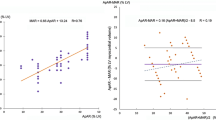Abstract
Background
To optimize the use of thallium 201 rest-redistribution study in Tl-201/technetium 99m sestamibi dual-isotope single photon emission computed tomography (SPECT), the predictability of Tl-201 rest-redistribution for viable myocardium was examined according to the degree of perfusion reserve.
Methods and Results
Twenty patients with both unstable angina and left ventricular dysfunction were enrolled. Tl-201 rest-dipyridamole stress Tc-99m sestamibi gated SPECT/Tl-201 24-hour redistribution SPECT was performed before and 3 months after coronary artery bypass grafting. Through use of a 20-segment model, segmental stress perfusion, rest perfusion, and systolic thickening were quantified on gated SPECT by means of automatic quantitation software. Perfusion was expressed as the average percentage of maximal radioactivity uptake. To represent perfusion reserve, the perfusion difference score (PDS) was defined as rest perfusion minus stress perfusion. A low PDS indicated little or no inducible ischemia, and a high PDS indicated inducible ischemia. In dysfunctional myocardium, viability was defined by the improvement of thickening after coronary artery bypass grafting. The overall predictability of Tl-201 redistribution for viability was 0.709 of the area under the curve (AUC) in receiver operating characteristic analysis. With a cutoff of 7, predictability was significantly better in the low PDS group (AUC = 0.785) than in the high PDS group (AUC = 0.582).
Conclusions
The predictability of Tl-201 rest-redistribution for viability differs according to perfusion reserve. It was more reliable for dysfunctional myocardium with persistent perfusion decrease. On the basis of the continuum hypothesis of chronic stunning and hibernation, we suggest that dysfunctional myocardium with persistent perfusion decrease should be assessed by Tl-201 redistribution SPECT.
Similar content being viewed by others
References
Rahimtoola SH. A perspective on the three large multicenter randomized clinical trials of coronary bypass surgery for stable angina. Circulation 1985;72:V123–35.
Braunwald E, Rutherford JD. Reversible ischemic left ventricular dysfunction: evidence for the “hibernating myocardium.” J Am Coll Cardiol 1986;8:1467–70.
Rahimtoola SH. The hibernating myocardium. Am Heart J 1989;117:211–21.
Camici PG, Wijns W, Borgers M, De Silva R, Ferrari R, Knuuti J, et al. Pathophysiological mechanisms of chronic reversible left ventricular dysfunction due to coronary disease (hibernating myocardium). Circulation 1997;96:3205–14.
Wijns W, Vatner SF, Camici PG. Hibernating myocardium. N Engl J Med 1998;339:173–81.
Vanoverschelde JL, Wijns W, Depre C, Essamri B, Heyndrickx GR, Borgers M, et al. Mechanisms of chronic regional postischemic dysfunction in humans: new insights from the study of noninfarcted collateral-dependent myocardium. Circulation 1993;87:1513–23.
Shen YT, Vatner SF. Mechanism of impaired myocardial function during progressive coronary stenosis in conscious pigs. Hibernation versus stunning? Circ Res 1995;76:479–88.
Fallavollita JA, Perry BJ, Canty JM Jr. 18F-2-deoxyglucose deposition and regional flow in pigs with chronically dysfunctional myocardium: evidence for transmural variations in chronic hibernating myocardium. Circulation 1997;95:1900–9.
Shivalkar B, Flameng W, Szilard M, Pislaru S, Borgers M, Vanhaecke J. Repeated stunning precedes myocardial hibernation in progressive multiple coronary artery obstruction. J Am Coll Cardiol 1999;34:2126–36.
Canty JM Jr, Fallavollita JA. Chronic hibernation and chronic stunning: a continuum. J Nucl Cardiol 2000;7:509–27.
Canty JM Jr. Myocardial perfusion-contraction matching. In: Heyndrickx GR, Vatner SF, Wijns W, editors. Stunning, hibernation, and preconditioning: clinical pathophysiology of myocardial ischemia. Philadelphia: Lippincott-Raven; 1997. p. 49–68.
Parodi O, Schelbert HR, Schwaiger M, Hansen H, Selin C, Hoffman EJ. Cardiac emission computed tomography: underestimation of regional tracer concentration due to wall motion abnormalities. J Comput Assist Tomogr 1984;8:1083–92.
Heusch G. Hibernating myocardium. Physiol Rev 1998;78:1055–85.
Canty JM Jr, Fallavollita JA. Rest myocardial flow in hibernating myocardium: validating animal models of human pathophysiology. Am J Physiol 1999;277:H417–22.
Bolli R. Myocardial ‘stunning’ in man. Circulation 1992;86:1671–91.
Rahimtoola SH. Concept and evaluation of hibernating myocardium. Annu Rev Med 1999;50:75–86.
Germano G, Erel J, Lewin H, Kavanagh PB, Berman DS. Automatic quantitation of regional myocardial wall motion and thickening from gated technetium-99m sestamibi myocardial perfusion single-photon emission computed tomography. J Am Coll Cardiol 1997;30:1360–7.
Germano G, Kavanagh PB, Waechter P, Areeda J, Van Kriekinge S, Sharir T, et al. A new algorithm for the quantitation of myocardial perfusion SPECT. I: Technical principles and reproducibility. J Nucl Med 2000;41:712–9.
Paeng JC, Lee DS, Cheon GJ, Lee MM, Chung J-K, Lee MC. Reproducibility of an automatic quantitation of regional myocardial wall motion and systolic thickening on gated Tc-99m-MIBI myocardial SPECT. J Nucl Med 2000;42:695–700.
Sharir T, Berman DS, Lewin HC, Friedman JD, Cohen I, Miranda R, et al. Incremental prognostic value of rest-redistribution 201Tl single-photon emission computed tomography. Circulation 1999;100:1964–70.
Kitsiou AN, Srinivasan G, Quyyumi AA, Summers RM, Bacharach SL, Dilsizian V. Stress-induced reversible and mild-to-moderate irreversible thallium defects: are they equally accurate for predicting recovery of regional left ventricular function after revascularization? Circulation 1998;98:501–8.
Heyndrickx GR, Millard RW, McRitchie RJ, Maroko PR, Vatner SF. Regional myocardial functional and electrophysiological alterations after brief coronary artery occlusion in conscious dogs. J Clin Invest 1975;56:978–85.
White FC, Carroll SM, Magnet A, Bloor CM. Coronary collateral development in swine after coronary artery occlusion. Circ Res 1992;71:1490–500.
Weich HF, Strauss HW, Pitt B. The extraction of thallium-201 by the myocardium. Circulation 1977;56:188–91.
Dilsizian V, Arrighi JA. Myocardial viability in chronic coronary artery disease: perfusion, metabolism, and contractile reserve. In: Gerson MC. Cardiac nuclear medicine. New York: McGraw-Hill; 1997. p. 143–91.
Author information
Authors and Affiliations
Corresponding author
Rights and permissions
About this article
Cite this article
Paeng, J.C., Lee, D.S., Cheon, G.J. et al. Consideration of perfusion reserve in viability assessment by myocardial Tl-201 rest-redistribution SPECT: A quantitative study with dual-isotope SPECT. J Nucl Cardiol 9, 68–74 (2002). https://doi.org/10.1067/mnc.2002.119688
Received:
Accepted:
Issue Date:
DOI: https://doi.org/10.1067/mnc.2002.119688




